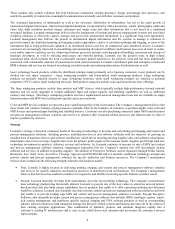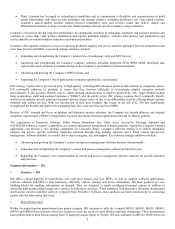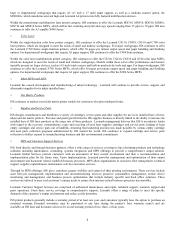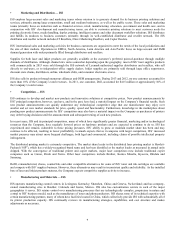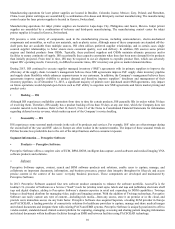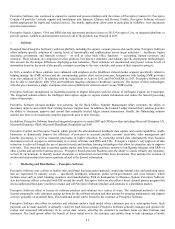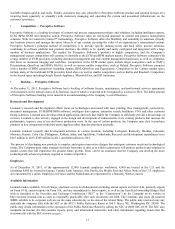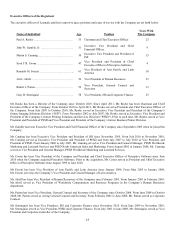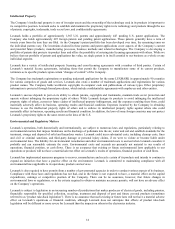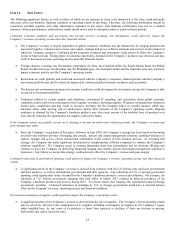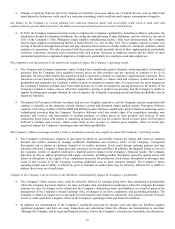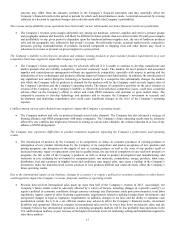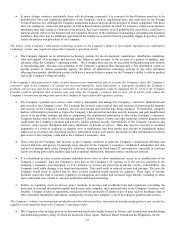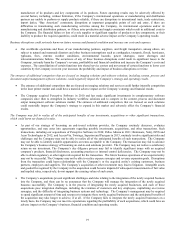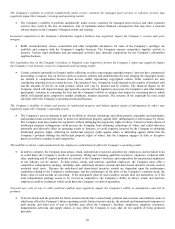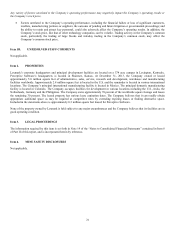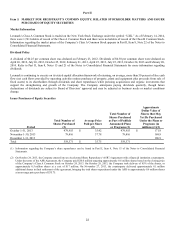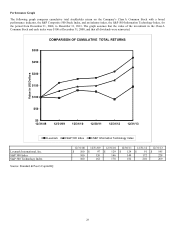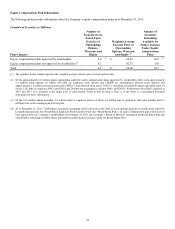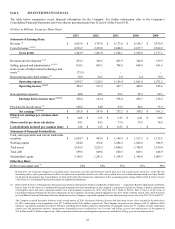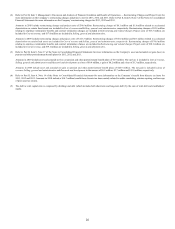Lexmark 2013 Annual Report Download - page 20
Download and view the complete annual report
Please find page 20 of the 2013 Lexmark annual report below. You can navigate through the pages in the report by either clicking on the pages listed below, or by using the keyword search tool below to find specific information within the annual report. Changes of printing behavior driven by adoption of electronic processes and/or use of mobile devices such as tablets and
smart phones by businesses could result in a reduction in printing, which could adversely impact consumption of supplies.
Any failure by the Company to execute planned cost reduction measures timely and successfully could result in total costs and
expenses that are greater than expected or the failure to meet operational goals as a result of such actions.
In 2012, the Company announced certain actions to improve the Company’s profitability, including workforce reductions, the
elimination of inkjet development worldwide, the exiting the manufacturing of inkjet hardware, and the closure by the end of
2015 of the Company’s Cebu, Philippines inkjet supplies manufacturing facility. After such announcement, the Company
sold its inkjet supplies manufacturing facility to Funai Electric Co., Ltd. in May 2013. The Company expects to realize cost
savings in the future through these actions and may announce future actions to further reduce its worldwide workforce and/or
centralize its operations. The risks associated with these actions include potential delays in their implementation, particularly
workforce reductions; increased costs associated with such actions; decreases in employee morale and the failure to meet
operational targets due to unplanned departures of employees, particularly key employees and sales employees.
The competitive pricing pressure in the market may negatively impact the Company’s operating results.
The Company and its major competitors, many of which have significantly greater financial, marketing and/or technological
resources than the Company, have regularly lowered prices on their products and are expected to continue to do so. In
particular, the laser printer market has experienced and is expected to continue to experience significant price pressure. Price
reductions on laser products, including related supplies or the inability to reduce costs and expenses, could result in lower
profitability and jeopardize the Company’s ability to grow or maintain its market share. In recent years, the gross margins on
the Company’s hardware products have been under pressure as a result of competitive pricing pressures in the market. If the
Company is unable to reduce costs to offset this competitive pricing or product mix pressure, and the Company is unable to
support declining gross margins through the sale of supplies, the Company’s operating results and future profitability may be
negatively impacted.
The market for Perceptive Software’s products and services is highly competitive, and the Company expects competition will
continue to intensify as the enterprise content, business content and document output markets mature. Perceptive Software
competes with a large number of ECM, BPM and DOM providers that have significantly greater financial, marketing and/or
technological resources than the Company. Perceptive Software could lose market share if its competitors introduce new
products and services, add functionality to existing products, or reduce prices on their products and services. If such
competitors lower prices with respect to competing products and services we could be forced to lower prices for Perceptive
Software’s products and services, which could result in less revenue or reduced gross margins, either of which may
negatively impact the Company’s operating results and future profitability.
The Company’s failure to manage inventory levels or production capacity may negatively impact the Company’s operating results.
The Company’s performance depends in part upon its ability to successfully forecast the timing and extent of customer
demand and reseller demand to manage worldwide distribution and inventory levels of the Company. Unexpected
fluctuations (up or down) in customer demand or in reseller inventory levels could disrupt ordering patterns and may
adversely affect the Company’s financial results, inventory levels and cash flows. In addition, the financial failure or loss of a
key customer, reseller or supplier could have a material adverse impact on the Company’s financial results. The Company
must also be able to address production and supply constraints, including product disruptions caused by quality issues, and
delays or disruptions in the supply of key components necessary for production. Such delays, disruptions or shortages may
result in lost revenue or in the Company incurring additional costs to meet customer demand. The Company’s future
operating results and its ability to effectively grow or maintain its market share may be adversely affected if it is unable to
address these issues on a timely basis.
Changes in the Company’s tax provisions or tax liabilities could negatively impact the Company’s profitability.
The Company’s future income taxes could be adversely affected by earnings being lower than anticipated in jurisdictions
where the Company has lower statutory tax rates and higher than anticipated in jurisdictions where the Company has higher
statutory tax rates, by changes in the valuation of the Company’s deferred tax assets and liabilities, as a result of gains on the
management of the Company’s foreign exchange risks, or changes in tax laws, regulations, and accounting principles. The
Company is subject to regular review and audit by both domestic and foreign tax authorities. Any adverse outcome of such a
review or audit could have a negative effect on the Company’s operating results and financial condition.
In addition, the determination of the Company’s worldwide provision for income taxes and other tax liabilities requires
significant judgment, and there are many transactions and calculations where the ultimate tax determination is uncertain.
Although the Company, and its legal and financial advisors, believe the Company’s estimates are reasonable, the ultimate tax
16


